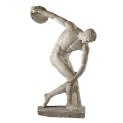RETURN
DOWNLOAD PDF
BACKGROUND - What was life like for the young King Henry VIII
Throughout the ages, the desirable qualities sought by the ruling classes, their personal views and their religious beliefs have influenced their lifestyles and sports played, and these in turn have affected the lifestyle of their subjects.
Influenced by fashion, trends and foreign societies, English Kings and the ruling classes in the Middle Ages modelled themselves on the ideal of the ‘Renaissance man’. They sought to be well-educated, literate, good at music, dancing, singing, languages and glorified sporting prowess. The young Henry led an extremely privileged life, and was not only good at sport but extremely cultured. By the time he was crowned in 1509, Henry could speak French and Latin, and understood Italian: he composed music, played musical instruments and sang extremely well. He was extremely rich and was worth over a million pounds then !! He owned 63 houses, and at Greenwich palace had kennels, stables, real tennis courts and towers for mock battles where he would re-enact fantasy battles set in the days of King Arthur and the Round Table. He celebrated Christmas in 1524 with a string of jousting tournaments, dancing, feasting and hunting. As king of England the world existed for his pleasure, and the pleasure of the very rich and powerful. He wanted his name to be associated with the ideals of the mythical past from the Age of chivalry along with knights in shining armour, even though warfare had progressed beyond that with the discovery of gunpowder.
On May Day in 1515, his queen, Catherine of Aragon, led a pageant - large group of nobles, ambassadors and ladies on horseback out of Greenwich palace towards a wood near Shooters Hill, where they met with King Henry and his followers of 100 noblemen all dressed like Robin hood and his merry men. The queen was accompanied by 25 damsels riding white ponies. The entire procession was watched by 25,000 people, much like thousands turn up nowadays to see the queen outside Buckingham Palace.
Pageantry and a sense of occasion was loved by the ruling classes. Everybody tried hard to please the King by indulging him whenever possible. After all, no-one would want to get on the wrong side of him and find themselves sentenced to be hung, drawn and quartered !!
Henry was a brilliant sportsman: his favourite sport was jousting – two fully armoured men each on the back of a horse, charging towards each other with a lance (as in the film ‘a knight’s tale): the object was to break the other persons lance. The sport was wrapped up in very strict rules and codes of conduct, according to the laws of chivalry of course. Henry jousted nearly every day and used to boast that he would take on anybody. Until, that is, when he was concussed in a tournament when a lance pierced his helmet and splintered inside it – he nearly lost his sight. After that he looked at gentler sports and became interested in Real Tennis, so started a trend: anyone who wanted to win the king’s favour would build a tennis court at his castle so that he could be a good host if the king announced that he was going to visit ! Henry, and his chosen lifestyle, was a role model to the hundred or so of his loyal noblemen . they all wanted to emulate him and would have copied and indulged him. Real, or Royal tennis originated in France and became popular in England in the fourteenth century, amongst kings, nobles and merchants. The courts were expensive and very sophisticated, had complex rules and needed a high level of skill. Henry had a court at Greenwich Palace and later at Hampton Court palace (still used today). He wasn’t very good at it and often lost money on bets he made ! Most University Colleges had a court: Charles l played at Oxford !!
The peasants of the day wouldn’t have been able to pursue the same sports as the privileged rich. They would have been able to play mob football on special festival days – occasions such as May Day and Shrove Tuesday and other festive holidays, but their lives were tough and the idea of ‘leisure time’ didn’t exist. Mob football would be little more than street fights on occasions ! English society in the 16th Century was two-tiered – there were only two classes: the ruling classes and peasants ! At festivals, local women might run in a smock race to win a dress, and people might play ‘cat in a bowl’ where a kitten would meet its maker at the hands of cruel youths. Animal baiting flourished: bear and bull baiting, ratting contests and cock-fighting.


